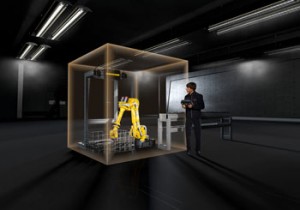FANUC robots and safety combine to boost productivity
 When implementing a robot cell one of the major considerations must be the safety of operators and people working in the area. Modern robots are almost silent in operation and very fast. Manufacturers can enjoy the best of both worlds of high levels of operator safety combined with optimised productivity using FANUC’s Dual Check Safety (DCS) technology with a safety scanner and safety camera. Robots can slow down as people approach the robot cell and come to a standstill when a hand moves into the cell itself.
When implementing a robot cell one of the major considerations must be the safety of operators and people working in the area. Modern robots are almost silent in operation and very fast. Manufacturers can enjoy the best of both worlds of high levels of operator safety combined with optimised productivity using FANUC’s Dual Check Safety (DCS) technology with a safety scanner and safety camera. Robots can slow down as people approach the robot cell and come to a standstill when a hand moves into the cell itself.
Take a typical food packaging application involving a FANUC LR Mate 200iD picking produce from different tubs and pots to create mixed retail trays, as demanded by today’s supermarkets – both to create appealing in-store displays and to minimise product waste. Traditionally the cell is guarded on two sides and on the remaining two sides safety scanning technologies are employed from Rockwell Automation – an Allen-Bradley GuardMaster SC300 hand detection safety sensor and a SafeZone safety laser scanner.
The SafeZone safety laser scanner is set up on the cell to create two 1m wide corridors to approach the cell. When a person enters the corridor to say feed in produce or to remove a filled tray – the robot slows its operational speed. FANUC regional sales manager John Rainer comments: “If someone accidentally gets closer to the robot than they should, you don’t necessarily want it to stop automatically. Slowing down might be a more appropriate response: it helps to optimise productivity, but at the same time eliminates sudden stoppages at high speeds which could lead to vacuum gripped parts being dropped due to the high inertia”.
Only when a person puts a hand through the SC300 safety sensor will the robot stop. This vision-based protective device uses image processing technology to detect the intrusion of objects through its detection window. The sensor is continuously looking for a reflected pattern from special reflective tape around the cell entry window. When an object of a certain resolution blocks the device’s view of the pattern, the safety function is activated.
These two devices work in conjunction with FANUC’s DCS software-based safety options which safely monitor the robot’s position and speed, allowing safety zones to be quickly and easily designed. DCS Position Check ensures that the robot stays inside designated safe areas, with adaptive zones that allow for more compact cell layouts and which allow robots and humans to share a common space in a controlled way.
The DCS Speed Check functionality makes it possible to define the maximum speed that the robot can travel during normal operation, and the speed at which it must slow to in reaction to a defined event – in this case a person entering the approach corridor. It also ensures that the robot holds a position when necessary – here when a hand enters the robot cell.
John concludes “Because the robot is only slowing down when an operator approaches, rather than stopping immediately, straight away there is a productivity gain. Further, since DCS Speed Check can hold the robot at standstill when an object enters the cell, rather than the safety system enforcing a hard shut down, the cell can be up and running again much more quickly. The result is an assured level of safety along with optimised productivity.”
Visit the FANUC website for more information.
See all stories for FANUC















